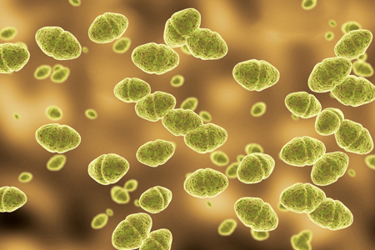Why Lactococcus Lactis Might Be The Best Membrane Protein Factory
By Annie Frelet-Barrand, Institute FEMTO-ST

Membrane proteins (MPs) perform a wide variety of functions vital to the survival of organisms. Involved in numerous pathologies, they are very important drug targets.1 In spite of their functional and biotechnological importance, their study remains difficult due to their hydrophobicity and low abundance in cells. Their overexpression in heterologous systems is mandatory for their detailed structural and functional characterization. However, this strategy leads to numerous obstacles such as their toxicity to hosts and the quality of the MP produced in these systems, especially for structural studies.2
Among the different expression systems, Lactococcus lactis, a gram-positive bacterium considered the model lactic acid bacteria, emerged at the beginning of the 21st century as a good alternative for functional expression and characterization of prokaryotic and eukaryotic MPs.3,4 It grows at 30 degrees C with a doubling time of 35 to 60 minutes under fermentation or respiration. Already largely used in industry for the production of fermented foods and consumed by humans for hundreds of years, this “generally recognized as safe” (GRAS) microorganism can express homologous and heterologous proteins and soluble and membrane proteins, including therapeutic proteins and bacterial and viral antigens for vaccination even at the industrial scale. 5 L. lactis is easy and inexpensive to grow; a large variety of genetic methods and vector systems are now available and well developed, although to a less extent compared to those available for E. coli.
Within the last 10 years, different strategies have been developed to improve and increase cloning efficacy.4 L. lactis is also an interesting alternative host, especially for MPs, because of its moderate proteolytic activity, the absence of inclusion-body formation and endotoxin production, and its efficient targeting of the MPs into a single plasma membrane. The absence of endotoxin allows for the use of the bacteria or the protein produced for biotechnological and therapeutic applications.
Moreover, this bacterium allows functional studies directly within intact cells and membrane vesicles. It possesses different lipids within the membrane and is particularly rich in glycolipids and cardiolipin, lipids not present in E. coli membranes. Since lipids are essential for MP stability, conformations, and functionality, this specific lipid composition could have a positive influence on the expression and the functionality of the MP produced.
Among the different gene expression systems available in L. lactis, the tightly regulated nisin-controlled gene expression (NICE) system is the most broadly and commonly used.6 This promising and effective expression system was developed for lactic acid bacteria and is based on genes involved in the biosynthesis and regulation of the antimicrobial peptide nisin, a product of the nisA gene. This 34-amino-acid bacteriocin produced by several strains of L. lactis can also be used as a natural food preservative.
The genes of the two-component signal transduction system, nisK and nisR, from the nisin gene cluster were inserted into the chromosome of L. lactis subsp. cremoris MG1363 (nisin-negative) to create the strain NZ9000. When a gene of interest is subsequently placed behind the inducible promoter PnisA in a plasmid, the expression of that gene can be induced by the addition of sub-inhibitory amounts of nisin (0.1 to 5 ng/mL) to the culture medium, either obtained commercially or by adding the more effective supernatant from the NZ9700 nisin-secreting lactococcal strain. In order to obtain higher yields, the growth medium, fermentation conditions, and nisin induction can be optimized.
Using the NICE system and the L. lactis strains, in the last 20 years, 115 MPs from prokaryotic or eukaryotic origin, with diverse topologies (0 to 14 transmembrane helices) and sizes (11.2 to 168 kDa), have been successfully expressed allowing for either their functional and/or structural characterization. 3,4 This system also allows properly folded MP expression in their native oligomeric form (homo or heterodimers). Recently, one eukaryotic membrane protein was expressed at a relatively high expression yield and allowed the formation of heterologous intracellular vesicles within the bacteria.7 As of September 2023, 21 3D structures of MP have been determined after expression of MP within this bacterium.
Over the last two decades, L. lactis emerged and proved to be an alternative and promising expression system compared to other bacterial systems. This attractive cell factory will enrich the knowledge of proteins, including MPs in their functional and structural states, and bring about the development of further biotechnological and biotherapeutic applications in the near future.
References
- Lundstrom K. Structural genomics and drug discovery. J. Cell Mol. Med. 2007, 11, 224–238. https://doi.org/10.1111/j.1582-4934.2007.00028.x
- Kesidis A., Depping P., Lodé A., Vaitsopoulou A., Bill R.M., Goddard A.D., Rothnie A.J. Expression of eukaryotic membrane proteins in eukaryotic and prokaryotic hosts. Methods 2020, 180, 3–18. https://doi.org/10.1016/j.ymeth.2020.06.006
- Bernaudat F., Frelet-Barrand A., Pochon N., Dementin S., Hivin P., Boutigny S., Rioux J.B., Salvi D., Seigneurin-Berny D., Richaud P. et al. Heterologous expression of membrane proteins: Choosing the appropriate host. PLoS ONE 2011, 6, e29191. doi: 10.1371/journal.pone.0029191.
- Frelet-Barrand A. Lactococcus lactis, an Attractive Cell Factory for the Expression of Functional Membrane Proteins. Biomolecules. 2022 Jan 22;12(2):180. doi: 10.3390/biom12020180.
- Song A.A., In L.L.A., Lim S.H.E., Rahim R.A. A review on Lactococcus lactis: From food to factory. Microb. Cell Fact. 2017, 16, 55. https://doi.org/10.1186/s12934-017-0754-1.
- Mierau I. & Kleerebezem M. 10 years of the nisin-controlled gene expression system (NICE) in Lactococcus lactis. Appl. Microbiol. Biotechnol. 2005, 68, 705–717. https://doi.org/10.1007/s00253-005-0107-6
- Flourieusse A., Bourgeois P., Schenckbecher E., Palvair J., Legrand D., Labbé C., Bescond T., Avoscan L., Orlowski S., Rouleau A., Frelet-Barrand A. Formation of intracellular vesicles within the Gram+ Lactococcus lactis induced by the overexpression of Caveolin-1β. Microb Cell Fact. 2022 Nov 17;21(1):239. doi: 10.1186/s12934-022-01944-9.
About the Author:
 Annie Frelet-Barrand. Ph.D., studied biochemistry, cellular and molecular biology at the University of Franche-Comté in France and graduated with an M.S. in 1998. In 2006, she received her Ph.D. in plant membrane protein (MP) characterization at the Institute of Plant Biology, Zurich. During her postdoctoral fellowship, she developed the bacterial Lactococcus lactis expression system for functional characterization of MPs and successfully expressed two-thirds of MPs of interest within the bacteria. Then, as CNRS researcher at CEA Saclay in France, she studied MPs involved in liver detoxification and functionally expressed two out of three. At Institute FEMTO-ST, she produces and characterizes diverse nano- and microelements from MPs, vesicles to bacteria and mammalian cells using biological, biochemical, and biophysical techniques. She has published 23 research articles and four book chapters.
Annie Frelet-Barrand. Ph.D., studied biochemistry, cellular and molecular biology at the University of Franche-Comté in France and graduated with an M.S. in 1998. In 2006, she received her Ph.D. in plant membrane protein (MP) characterization at the Institute of Plant Biology, Zurich. During her postdoctoral fellowship, she developed the bacterial Lactococcus lactis expression system for functional characterization of MPs and successfully expressed two-thirds of MPs of interest within the bacteria. Then, as CNRS researcher at CEA Saclay in France, she studied MPs involved in liver detoxification and functionally expressed two out of three. At Institute FEMTO-ST, she produces and characterizes diverse nano- and microelements from MPs, vesicles to bacteria and mammalian cells using biological, biochemical, and biophysical techniques. She has published 23 research articles and four book chapters.
